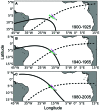Multi-Modal Homing in Sea Turtles: Modeling Dual Use of Geomagnetic and Chemical Cues in Island-Finding
- PMID: 26941625
- PMCID: PMC4761866
- DOI: 10.3389/fnbeh.2016.00019
Multi-Modal Homing in Sea Turtles: Modeling Dual Use of Geomagnetic and Chemical Cues in Island-Finding
Abstract
Sea turtles are capable of navigating across large expanses of ocean to arrive at remote islands for nesting, but how they do so has remained enigmatic. An interesting example involves green turtles (Chelonia mydas) that nest on Ascension Island, a tiny land mass located approximately 2000 km from the turtles' foraging grounds along the coast of Brazil. Sensory cues that turtles are known to detect, and which might hypothetically be used to help locate Ascension Island, include the geomagnetic field, airborne odorants, and waterborne odorants. One possibility is that turtles use magnetic cues to arrive in the vicinity of the island, then use chemical cues to pinpoint its location. As a first step toward investigating this hypothesis, we used oceanic, atmospheric, and geomagnetic models to assess whether magnetic and chemical cues might plausibly be used by turtles to locate Ascension Island. Results suggest that waterborne and airborne odorants alone are insufficient to guide turtles from Brazil to Ascension, but might permit localization of the island once turtles arrive in its vicinity. By contrast, magnetic cues might lead turtles into the vicinity of the island, but would not typically permit its localization because the field shifts gradually over time. Simulations reveal, however, that the sequential use of magnetic and chemical cues can potentially provide a robust navigational strategy for locating Ascension Island. Specifically, one strategy that appears viable is following a magnetic isoline into the vicinity of Ascension Island until an odor plume emanating from the island is encountered, after which turtles might either: (1) initiate a search strategy; or (2) follow the plume to its island source. These findings are consistent with the hypothesis that sea turtles, and perhaps other marine animals, use a multi-modal navigational strategy for locating remote islands.
Keywords: homing; magnetism; navigation; olfaction; sea turtles.
Figures









Similar articles
-
Island-finding ability of marine turtles.Proc Biol Sci. 2003 Aug 7;270 Suppl 1(Suppl 1):S5-7. doi: 10.1098/rsbl.2003.0022. Proc Biol Sci. 2003. PMID: 12952621 Free PMC article.
-
Marine turtles use geomagnetic cues during open-sea homing.Curr Biol. 2007 Jan 23;17(2):126-33. doi: 10.1016/j.cub.2006.11.062. Curr Biol. 2007. PMID: 17240337
-
Open-sea migration of magnetically disturbed sea turtles.J Exp Biol. 2000 Nov;203(Pt 22):3435-43. doi: 10.1242/jeb.203.22.3435. J Exp Biol. 2000. PMID: 11044382
-
There and back again: natal homing by magnetic navigation in sea turtles and salmon.J Exp Biol. 2019 Feb 6;222(Pt Suppl 1):jeb184077. doi: 10.1242/jeb.184077. J Exp Biol. 2019. PMID: 30728225 Review.
-
Geomagnetic imprinting: A unifying hypothesis of long-distance natal homing in salmon and sea turtles.Proc Natl Acad Sci U S A. 2008 Dec 9;105(49):19096-101. doi: 10.1073/pnas.0801859105. Epub 2008 Dec 5. Proc Natl Acad Sci U S A. 2008. PMID: 19060188 Free PMC article. Review.
Cited by
-
Behavioral effects of scents from male mature Rathke glands on juvenile green sea turtles (Chelonia mydas).J Vet Med Sci. 2020 Sep 24;82(9):1312-1315. doi: 10.1292/jvms.20-0058. Epub 2020 Jul 13. J Vet Med Sci. 2020. PMID: 32655096 Free PMC article.
-
Magnetic maps in animal navigation.J Comp Physiol A Neuroethol Sens Neural Behav Physiol. 2022 Jan;208(1):41-67. doi: 10.1007/s00359-021-01529-8. Epub 2022 Jan 9. J Comp Physiol A Neuroethol Sens Neural Behav Physiol. 2022. PMID: 34999936 Free PMC article. Review.
-
Orientation in high-flying migrant insects in relation to flows: mechanisms and strategies.Philos Trans R Soc Lond B Biol Sci. 2016 Sep 26;371(1704):20150392. doi: 10.1098/rstb.2015.0392. Philos Trans R Soc Lond B Biol Sci. 2016. PMID: 27528782 Free PMC article. Review.
-
A biphasic navigational strategy in loggerhead sea turtles.Sci Rep. 2020 Oct 22;10(1):18130. doi: 10.1038/s41598-020-75183-6. Sci Rep. 2020. PMID: 33093603 Free PMC article.
-
Spatial and life history variation in a trait-based species vulnerability and impact model.PLoS One. 2024 Jun 21;19(6):e0305950. doi: 10.1371/journal.pone.0305950. eCollection 2024. PLoS One. 2024. PMID: 38905300 Free PMC article.
References
-
- Akesson S., Broderick A. C., Glen F., Godley B. J., Luschi P., Papi F., et al. (2003). Navigation by green sea turtles: which strategy do displaced adults use to find Ascension Island? Oikos 103, 363–372. 10.1034/j.1600-0706.2003.12207.x - DOI
-
- Allard M. W., Miyamoto M. M., Bjorndal K. A., Bolten A. B., Bowen B. W. (1994). Support for natal homing in green turtles from mitochondrial DNA sequences. Copeia 1994, 34–41. 10.2307/1446668 - DOI
-
- Bleck R. (2002). An oceanic general circulation model framed in hybrid iopycnic-Cartesian coordinates. Ocean Model. 37, 55–88. 10.1016/s1463-5003(01)00012-9 - DOI
-
- Bracis C., Anderson J. J. (2012). An investigation of the geomagnetic imprinting hypothesis for salmon. Fish. Oceanogr. 21, 170–181. 10.1111/j.1365-2419.2012.00617.x - DOI
LinkOut - more resources
Full Text Sources
Other Literature Sources
Research Materials

